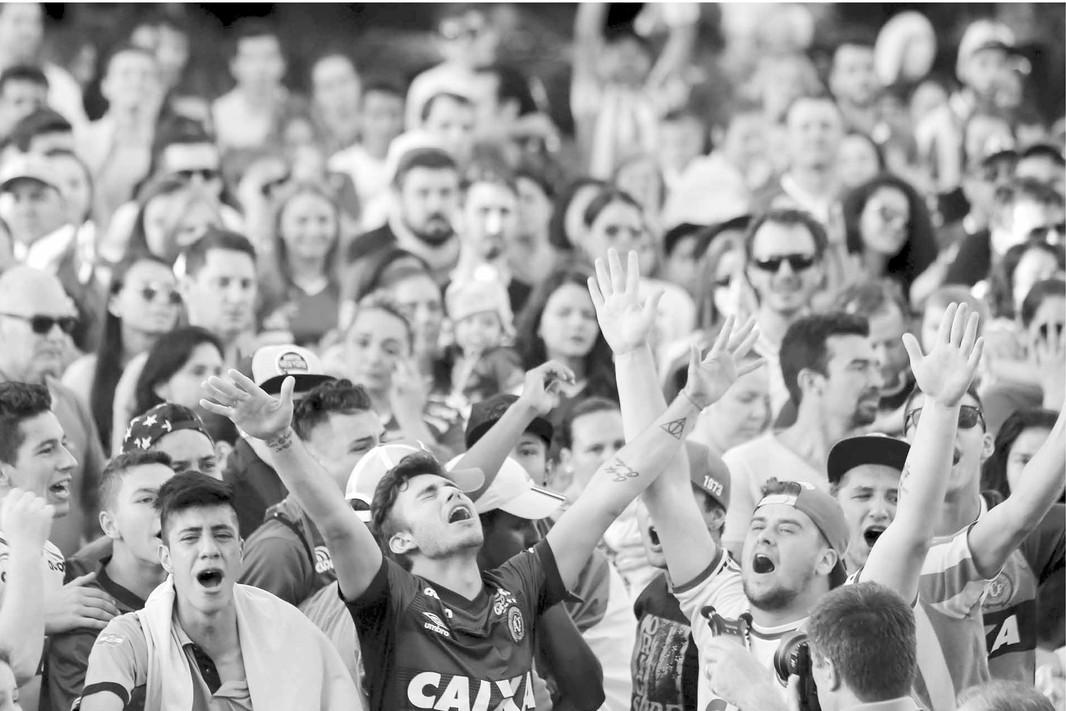JOY, THEN GRIEF, OVER BRAZIL TEAM
Plane Crash Devastates Soccer-Loving Nation
RIO DE JANEIRO — After climbing the ranks of Brazilian soccer, the team was on its way to face one of its biggest tests yet: a chance to win the final of the Copa Sudamericana, an international competition for South American soccer.
But over the mountains near Medellín, Colombia, the plane carrying the members of Chapecoense, a soccer team from a scrappy industrial city in southern Brazil, made an emergency call on Monday night after experiencing an electrical failure, the authorities said.
Moments later, it crashed into the mountains with 77 people aboard.
‘At times like this, the shock is so intense that it’s nearly impossible to remain calm.’
Only six people survived the crash, aviation officials said: three players, two crew members and a journalist who was accompanying the team. The rest were presumed dead, a devastating turn for one of the most remarkable success stories in the tumultuous, scandal-plagued world of Brazilian soccer.
“This is a relatively small city, so everyone knows somebody who was on the plane,” said Roberto Panarotto, 44, a professor of media studies in Chapecó, the team’s hometown. He said he had lost a childhood friend, a member of the coaching staff, in the crash.
Fans across Brazil had been reveling in Chapecoense’s performance. Brazil has been grappling with extraordinary upheaval this year, including the impeachment of its president, the most severe economic crisis in decades and a jaw-dropping array of political corruption scandals.
In the world of Brazilian sports alone, the United States Justice Department has indicted the most powerful executives in Brazilian soccer on graft charges. A former governor of Rio de Janeiro, who helped land the 2016 Summer Olympics, is in jail on charges that he took bribes in a deal to renovate the city’s Maracanã stadium.
And now, just as Brazilian soccer appeared to be on the mend after the national team won the gold medal in Rio, the crash left many across the nation stunned.
“I’ve never seen or felt anything like this in 46 years of journalism,” said Juca Kfouri, 66, one of Brazil’s most eminent soccer columnists. “At times like this, the shock is so intense that it’s nearly impossible to remain calm.”
Camilo Tobón, a rescue worker, described approaching the wreckage near midnight, not knowing if there would be survivors. “The first thing I saw was the tail of the plane completely shattered,” he said. “There was baggage everywhere.”
But soon, voices were heard.
“There were people calling for help; you could hear them,” said Jenifer Cardona, a firefighter who helped rescue a Chapecoense goalkeeper as well as a crew member. Ms. Cardona said she had found the two still conscious inside the airplane, a British Aerospace 146 that had taken off from Santa Cruz, Bolivia, pinned against debris and tree branches.
But hope had run out for others, Ms. Cardona said. “There are no more wounded, just the dead,” she said.
At least 21 journalists were reported to be aboard the plane as well, including reporters from Fox Latin America, the Globo television network and news organizations from southern Brazil. All but one died, the authorities said. At first, the Colombians reported that 81 people had been aboard the plane; they later revised the number to 77.
Less than a decade ago, Chapecoense was playing in the obscurity of Brazil’s fourth division, making few ripples in the soccer world. But a spectacular rise placed the team near the pinnacle of Brazilian soccer.
In southern Brazil, the team was the pride of Chapecó, a staid city of 210,000 known for its food processing plants. Fans attributed Chapecoense’s ascent to prudent, transparent management, including cooperation with local business leaders who helped pull the team out of a financial crisis over the past decade.
“Lots of football clubs in Brazil have problems in the way they are run, with corruption and bad management practices, but Chapecoense is different,” Professor Panarotto said.
The pride in Chapecó stands in contrast to the disdain many Brazilians express when it comes to some other facets of Brazilian soccer. Despite the gold medal this summer, there is still lingering dismay over the debacle of Brazil’s loss to Germany during the 2014 World Cup in Brazil. Stadiums built or upgraded for the World Cup are now the focus of corruption investigations over accusations of bribes paid to politicians.
José Maria Marin, the former president of Brazil’s soccer federation, was arrested in Switzerland last year on corruption charges and is now under house arrest at his Trump Tower apartment in Manhattan. In 2015, the United States Justice Department also indicted Marco Polo Del Nero, the current president of the federation, on corruption charges.
Still, Mr. Del Nero remains in his post. Delfim Peixoto, a rival seeking to unseat him, was among the officials traveling with Chapecoense who died in the crash, according to Brazil’s national soccer federation. Mr. Peixoto, a former federal legislator from the state of Santa Catarina, was a vice president representing southern Brazil in the national soccer federation.
In a televised address, President Juan Manuel Santos of Colombia called the crash “a tragedy that has the whole region in mourning.”
The Copa Sudamericana match this week, which was suspended by soccer officials early Tuesday, was set to be played against a Colombian team on Wednesday in Medellín. On Tuesday, that team, Atlético Nacional, asked the South American Football Confederation to award Chapecoense the trophy as a “posthumous homage to the victims.”
In Brazil, soccer officials suspended all games for a seven-day mourning period, and the teams in Brazil’s top league released a statement offering to loan players to Chapecoense so that it could return to the field.
In the world of Brazilian soccer, Chapecoense was an upstart from a humdrum city. While famed Brazilian teams like Fluminense, Corinthians and Pelé’s old team, Santos, were founded around the start of the 20th century, Chapecoense came to life much later, in 1973.
In its debut last year in the Copa Sudamericana tournament, it surprised many by making the quarterfinals. This year it topped that, spectacularly.
Beginning in August, the team sequentially knocked off rivals from Brazil, Argentina and Colombia — including San Lorenzo of Argentina, the team favored by Pope Francis — to make the final.
The team accomplished a lot without relying on big-name superstars. Its top scorer, Bruno Rangel, was a 34-year-old journeyman with more than a dozen stops on his résumé. The team captain, Cléber Santana, 35, had plied his trade all over Brazil and also in Spain. Both were killed, according to an official list of the dead that was confirmed by the team.
The final of the Copa Sudamericana was to be held over two legs, first in Medellín and then in Brazil, in the southern city of Curitiba. The matches were to have been the biggest in Chapecoense’s history by a long way.
Jéssica Canofre, 21, an engineering student in Chapecó, said that people in the city had been scrambling to get to Curitiba for the game.
“All the buses had been booked, there were none left,” she said by telephone, weeping as she described the sense of dismay on Tuesday.
“The city is paralyzed. Everything has completely stopped. Classes have been canceled, everything,” Ms. Canofre said. “Everyone was mobilized behind the team and so happy. I just want to go back to yesterday.”
Only a decade ago, Chapecoense was mired in debt, a situation common among Brazilian soccer teams. But a group of business leaders in Chapecó came together to bail the team out, installing new management.
The turnaround worked to the point where Chapecoense became known for frequently paying their players in advance, in addition to coveted bonuses. Investments in training installations also paid off, with the team’s improving fortunes luring a solid fan base in a national soccer scene marked by dismal stadium attendance in many cities.
Echoing Chapecoense’s ascent, the fortunes of Brazil’s national team have also been on the rise, including the gold medal at the Rio Olympics. And with a new coach at the helm, Adenor Leonardo Bacchi — better known as Tite — the team has won all six of its last 2018 World Cup qualifying matches.
But the crash of Chapecoense’s plane cast a pall over the improving mood.
“In a country where so many think they are giants, Chapecoense knew their size and how much they could grow,” said André Rocha, a prominent writer on Brazilian soccer. He called the team “a moral example.”
Simon Romero reported from Rio de Janeiro, and Nicholas Casey from New York. Reporting was contributed by Andrew Das, Randal C. Archibold and Victor Mather from New York; Rory Smith from Rome; Claire Rigby and Paula Moura from São Paulo, Brazil; and Susan Abad from Bogotá, Colombia.



Earn FREE bitcoins over at Easy Bitcoin. Up to 33 satoshis every 10 minutes.
ReplyDelete